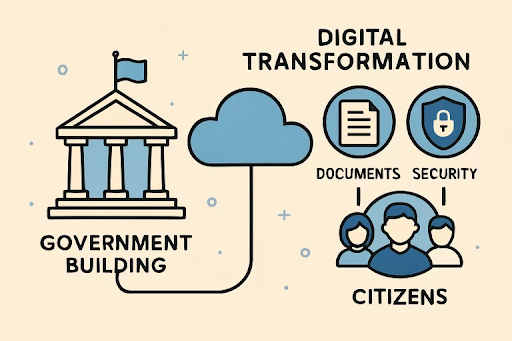
Key Takeaways
- Cloud services enhance efficiency and scalability in government operations.
- They improve data security and compliance with regulations.
- Cloud solutions facilitate better citizen engagement through digital services.
- Adoption of cloud technologies leads to cost savings and resource optimization.
Table of Contents
- Introduction
- Enhancing Efficiency and Scalability
- Improving Data Security and Compliance
- Facilitating Citizen Engagement
- Achieving Cost Savings and Resource Optimization
- Overcoming Challenges in Cloud Adoption
- Future Trends in Government Cloud Services
- Conclusion
Introduction
Government agencies often utilize outdated IT systems that are costly, difficult to modify, and exhibit slow performance. These older systems require a lot of money for new hardware, regular upkeep, and paying for medical IT professionals to ensure everything is working as needed. As digitization of government services progresses and citizens’ expectations shift, agencies have a greater need to update their frameworks and processes. Enhanced legacy systems allow the launch of new programs and rapid reactions to crises, enabling the use of adaptive technologies.
The emergence of cloud services has transformed the public sector with a modernization of approach to service delivery and public interaction, enabling wide-reaching changes in how programs are delivered and citizens engage with government. Adoption of cloud services leads to better agility and a significant decrease in the time needed to implement updates and new technologies or scale operations. Partners like Arctic IT are actively supporting public sector organizations with their transition to cloud-first strategies, fueling a culture of innovation and raising the standard of service delivery for citizens nationwide.
Enhancing Efficiency and Scalability
In the context of governments, cloud computing transforms internal workflows because it allows agencies to automate complex and repetitive steps, which consume a considerable amount of time and resources. Workflows that are automated speed up the processing of applications, benefits, licensing, communication within and between departments, and review of applications. Manual processes that used to slow down IT departments in the provision of services are eliminated, and cloud systems diminish the redundancies that used to slow down older IT systems.
In terms of scalability, the adoption of cloud services offers government offices a solid infrastructure that can elastically expand to meet changing needs. The cloud, for example, can provide additional resources during peak demand, like tax reporting periods or during public health emergencies. This capability greatly enhances public service efficiency. Cloud services also eliminate the strain associated with costly infrastructure that is underused because it requires agencies to handle unexpected spikes in demand without compromising performance. Now, there is a much better chance to create new ideas without facing high cloud computing costs or needing to make big changes to the systems, which allows for flexible growth in the cloud.
Improving Data Security and Compliance
As part of their digital transformation journey, public sector organizations continue to prioritize security. Top cloud solution providers employ advanced layers of security, including modern encryption both in transit and at rest, identity and access management, AI-based threat intelligence, real-time system monitoring, and more. Traditional security measures, like encryption, often wait for breaches to occur and then respond to them. In contrast, cloud-based security measures actively seek out threats before they materialize. Because federal agencies tend to operate on limited budgets, the economies of scale and heightened security provided by cloud vendors are a game-changer for government IT.Compliance is equally essential. Government agencies must adhere to strict regulatory frameworks like FedRAMP (Federal Risk and Authorization Management Program), CJIS (Criminal Justice Information Services), and HIPAA (Health Insurance Portability and Accountability Act) when handling sensitive information. Cloud vendors have smartly designed their systems to circumvent legal trouble through compliance. Ensuring legal and technical compliance, alongside routine updates, audits, and documentation, enables public confidence in security posture and data compliance. Ultimately, this level of detail enables innovation while addressing the needs of public sector organizations.
As part of their digital transformation journey, public sector organizations continue to prioritize security. Top cloud solution providers employ advanced layers of security, including modern encryption both in transit and at rest, identity and access management, AI-based threat intelligence, real-time system monitoring, and more. Traditional security measures, like encryption, often wait for breaches to occur and then respond to them. In contrast, cloud-based security measures actively seek out threats before they materialize. Because federal agencies tend to operate on limited budgets, the economies of scale and heightened security provided by cloud vendors are a game-changer for government IT.
Facilitating Citizen Engagement
Like any other customer, citizens now expect a digital-first interaction with government agencies. This expectation stems from the use of private sector services. Today, dealing with the government as a resident is easier than ever with cloud-based digital services. Offering online portals, mobile applications, and self-service kiosks allows users to apply for permits, pay taxes, request documents, or ask questions around the clock from almost anywhere.
Digital transformation of government services means agencies need to be more adaptive and responsive. Moreover, cloud services enable rapid deployment; new agency services or policy changes can be implemented overnight. This ensures public resources are available during periods of heightened need or unanticipated events. Using advanced tools for engagement enables the public to offer two-way communication. Residents are empowered to share feedback and track the status of their applications while accessing government information with unprecedented ease and transparency, contributing towards a more satisfied and better-informed population.
Achieving Cost Savings and Resource Optimization
Migrating to the cloud is one of the most compelling advantages of cost savings over time. Traditional IT setups come with hefty costs in acquiring and maintaining servers, software licensing, and employing specialized IT staff. Agencies can shift to cloud-based models and transfer these costs because cloud vendors offer physical infrastructure maintenance, automated updates, and disaster recovery at a fixed subscription fee.
Most agencies have adopted cloud solutions and, in the process, reduced their capital expenditure and IT operating costs. Moreover, this change unshackles financial and human resources previously tied to system maintenance. Governments can reallocate finances to innovative projects and constituent-facing services, thereby increasing their impact on the public good. All these efficiencies add up to measurable and tangible value for taxpayers, which lies at the heart of all public sector missions.
Overcoming Challenges in Cloud Adoption
The past few years have seen organizations adopt cloud technology for its endless benefits. However, the journey to the cloud comes with its unique set of challenges. One of these challenges is institutional and cultural changes within the organization, as employees are required to shift their routines, duties, and responsibilities to new technologies. Public sector agencies also face challenges of migrating legacy data, integrating various platforms, and re-engineering existing cyber architectural defenses to work in a cloud-centric world.
These issues can be addressed with an elaborate change management plan, comprehensive retraining, and partnering with experienced vendors and consultancies. These issues can further be amplified with the establishment of frameworks for effective governance, prioritization of security investments, and phased migrations to avoid risk. Looking at peers and colleagues provides firsthand experience in secure pathways and steps towards a modernized government.
Future Trends in Government Cloud Services
Strategic clouds are being adopted for the government sector, leading to investment in new technologies. For instance, agencies can use artificial intelligence and machine learning for automating services, customizing citizen engagements, and conducting advanced analytics for policy-making based on robust data analysis. Auto applications of the Internet of Things and city initiatives will be enhanced through edge computing—data will be processed closer to its source, improving the responsiveness and resilience of government-termed programs. Advanced frameworks for responding to catastrophes in real time will owe their functioning to the cloud as well as inter-agency digital communication. Secure cloud solutions will owe their benefits to more governments, rapidly shifting the public sector towards a more advanced digital structure.
Conclusion
How government functions are visualized, developed, and delivered has changed completely due to cloud services. Today, public sector organizations can meet the evolving needs of their constituents due to having the agility, security, and scalability from adopting cloud technologies. As partners responsible for guiding the organizations through cloud technology prove their trust, the latter stand to benefit from improved governance.




